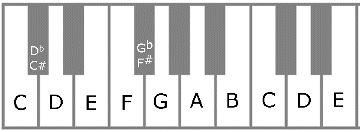''Music in the soul can be heard by the universe.''
Hello..everyone..MUSIC..has become one of the important necessity in today's world.
When one listens to music, usually the music is played in the background
while we do tasks such as work or household chores. The means we aren't
actively
listening to the music. Music can be a great, healing relaxer to help us escape from the various stresses of life these days.so guys why can't we enjoy the same feeling ,infact double by composing it.
lets get started off with basic concepts that one should know to enjoy the real taste of piano(keyboard).
The piano is an instrument that offers the musician eighty-eight musical
pitches organized in ascending order of pitch.
The lowest note is at the far left of the instrument, the highest note
on the far right.
These 88 pitches, generally speaking, are all the ones our human ears
can recognize as musical sounds. Pitches lower than the bottom note of a
piano: the low 'A', are so low as to sound like a rumble; any note
above the highest note on a piano. the high C, can be heard only by
plucky dogs. The piano organizes these pitches in a seemingly arbitrary
but ultimately logical system. When these notes are combined in various
rhythmic and harmonic patterns they produce music as diverse as that of
Mozart, Elton John and Ray Charles.
Let's look at the layout a bit. Here is a small (17-key) section of a
standard 88-key piano keyboard

The keys on a keyboard are a half-step apart. What is a half step? First
of all, it's just a word.
Some music people call a half-step a semi-tone (as opposed to a whole
tone). No matter what we call it,
it is the smallest DIFFERENCE in pitch between two notes that we can
hear. The distance between one
key and the next adjacent key is a half-step. The shark theme in "Jaws"
consists
of two notes a half-step apart, repeated over and over. If you don't
remember how this sounds, rent "Jaws." When
the shark shows up you hear these two notes. You'll never forget it!
Here are some facts about the keys on a keyboard that may seem obvious
but
research has shown that not everyone knows these facts:
- There are two styles of keys: black and white.
- The black keys are smaller than the white keys, and are grouped in twos and threes. Why? We'll get into that later.
- Despite these differences in how they look, black keys and white keys alike produce pitches (notes) that are a half-step apart.
- White notes are named using the first seven letters of the alphabet: A, B, C, D, E, F, G.
- Black notes are named using the first seven letters of the alphabet PLUS either a sharp sign (#) or a flat sign (b).
- The sharp sign (#) indicates a pitch is raised a half-step, so a
C# is just a C raised a half-step. If you look at the keyboard, this
makes sense. Because each key is a half-step away from the next key, and
the # sign raises a note a half-step, the black key next to the C must
be a C#.
- The flat sign (b) lowers a note a half-step. Using this same
logic, the Db key (first black key in our illustration) is a D note
lowered a half-step. Since each key is a half-step different in pitch
than the next note, the black key to the left of the D is a half-step
LOWER, and is therefore named a Db. A real flat sign looks a bit
flattened compared to a b, but I don't have that font. Sorry!

Some piano students are confused by what the "next note" means when we say the notes are a half-step apart.
This means you start on a key (any key) and the VERY NEXT key, black OR white, is a half-step different in pitch.You
don't just go from one white key to the next, you go to the next KEY, black OR white. The next key to the RIGHT is a
half-step HIGHER. The next key to the left is a half-step LOWER.
Good. So the keys on a keyboard are a half-step apart
from one another.The black keys are sort of wedged in there between the
white keys, but they are keys as well, with all the rights and
responsibilities of a key.
One more thing. The total number of half-steps that separate two notes is known as an interval.
From C to C# is an interval of a half-step. You can add half-steps
together, just like fractions in math. The interval from C to D is a
whole-step. Why? Because a half-step (C to C#) plus a half-step (C# to
D) is a whole step. Yup. You add half-steps together to make whole
steps.

